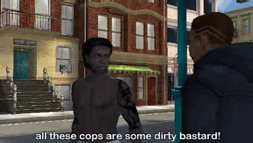
« PREVIOUS ENTRY
I like your style

Here’s an extremely cool project: “The French Democracy”, a machinima film about the recent riots in France. It’s a little dramatization of the lives of three different black French citizens. One is a teenager who gets apprehended by police and thrown in jail for an evening because he doesn’t have his passport on him; another is an MBA graduate who can’t find a job because he doesn’t look “French” enough; and the third is a drug dealer. Each boils up with rage until they decide to start rioting.
Now, this flick is hardly going to win the Palme d’Or at Cannes. But it’s easily one of the most impressive and emotionally affective pieces of machinima I’ve ever seen. When I was writing my feature this summer for the New York Times Magazine about machinima, I saw a lot of stuff that made me laff, but very little that made me think. This one accomplishes that, not merely because of its unexpectedly heartwarming political message, but because its cinematography has such a weirdly mongrel flavor: It borrows as often from the visual conventions of games as from film.
An example? At different points in the movie, the three main characters stand in the same place on a subway platform, fuming about their plight. Each time, there are characters in the background — one smoking, one just hanging around — and each time, although they’re different background characters, they’re in the exact same places, performing the exact same actions.
As anyone who’s played a lot of games knows, one of the funniest — or most annoying — elements in sloppily-designed games is that the game designers will simply create three or four basic figure models (a woman, a man, a child) with a few set expressions and movements, and then just replicate them ad infinitum around the world, while “reskinning” them to look individual. The upshot is that you keep on running into the “same” person over and over again, except with different clothes and hair. So there’s something lovely about the machinima creator explicitly referencing that in-game problem. It’s a clever metaphor that externalizes how the characters in this movie are feeling: Trapped in world where everyone around them is duplicitous, inhuman, and acting suspiciously alike.
There are plenty of other aesthetically nifty things about this movie, not least of which that the creator decided not to use voice-overs; the characters’ speech appears as slightly-mangled English along the bottom of the screen. This creates the odd effect of a movie that feels both incredibly new — it’s created using a video game — and incredibly old: It uses speech-frames straight out of silent movies. Better yet, the guy clearly didn’t do this to be selfconciously, superironically retro. He just doesn’t speak English very well and couldn’t afford voice actors who did. The raw DIY feel of this project is more punk rock than anything anyone’s done with music in about 20 years.
Anyway, enough of my jawing. Check this thing out now!
(Thanks to Paul Marino for this one!)
I'm Clive Thompson, the author of Smarter Than You Think: How Technology is Changing Our Minds for the Better (Penguin Press). You can order the book now at Amazon, Barnes and Noble, Powells, Indiebound, or through your local bookstore! I'm also a contributing writer for the New York Times Magazine and a columnist for Wired magazine. Email is here or ping me via the antiquated form of AOL IM (pomeranian99).

ECHO
Erik Weissengruber
Vespaboy
Terri Senft
Tom Igoe
El Rey Del Art
Morgan Noel
Maura Johnston
Cori Eckert
Heather Gold
Andrew Hearst
Chris Allbritton
Bret Dawson
Michele Tepper
Sharyn November
Gail Jaitin
Barnaby Marshall
Frankly, I'd Rather Not
The Shifted Librarian
Ryan Bigge
Nick Denton
Howard Sherman's Nuggets
Serial Deviant
Ellen McDermott
Jeff Liu
Marc Kelsey
Chris Shieh
Iron Monkey
Diversions
Rob Toole
Donut Rock City
Ross Judson
Idle Words
J-Walk Blog
The Antic Muse
Tribblescape
Little Things
Jeff Heer
Abstract Dynamics
Snark Market
Plastic Bag
Sensory Impact
Incoming Signals
MemeFirst
MemoryCard
Majikthise
Ludonauts
Boing Boing
Slashdot
Atrios
Smart Mobs
Plastic
Ludology.org
The Feature
Gizmodo
game girl
Mindjack
Techdirt Wireless News
Corante Gaming blog
Corante Social Software blog
ECHO
SciTech Daily
Arts and Letters Daily
Textually.org
BlogPulse
Robots.net
Alan Reiter's Wireless Data Weblog
Brad DeLong
Viral Marketing Blog
Gameblogs
Slashdot Games